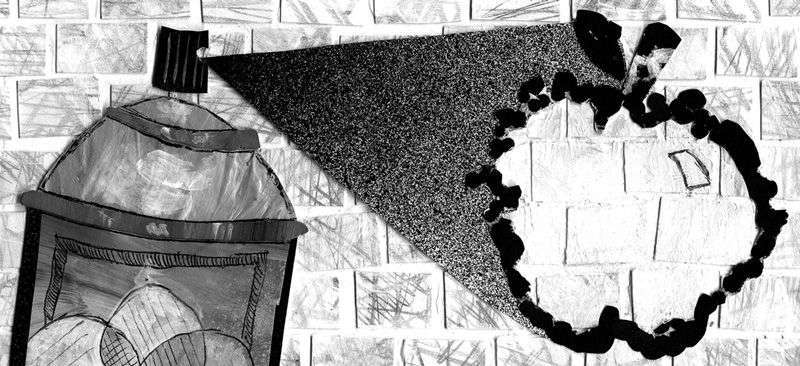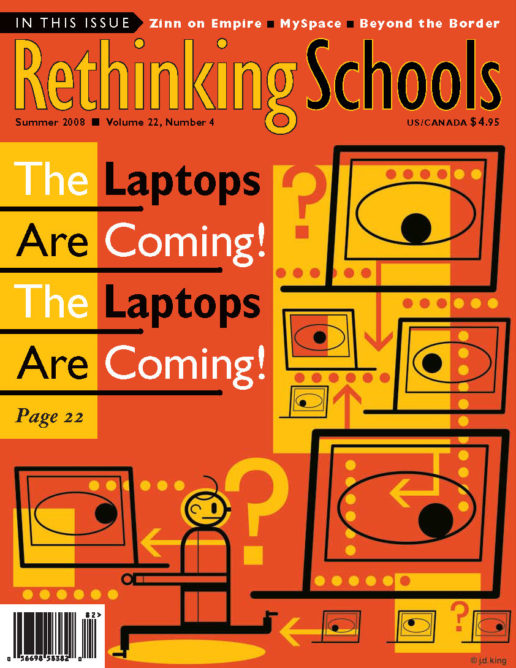City Teaching; Beyond the Stereotypes
Illustrator: Andy Perez

From the opening frames, it’s evident that Half Nelson isn’t going to be a conventional “urban teacher” film. It begins on the hardwood floor of a bare apartment, where Dan Dunne sits in his underwear, legs outstretched, a scraggly beard creeping down his neck, a dazed, spacey look in his eyes. An alarm clock buzzes insistently in the background. It’s time for Dan to leave for school, but he’s struggling to peel himself off his living room floor. Soon, we understand why: in addition to being a social studies teacher and the girls’ basketball coach at a Brooklyn junior high school, he’s a crack addict, a basehead.
Dan wants to be a good teacher, and even when he’s coming unglued personally-which is often-he does his best to hold it together for his students. In his classroom he ditches the prescribed curriculum and asks his black and Latino kids to wrestle with tough questions. His methods are part Socratic seminar, part didactic ramble, but his lessons push students to think, to make connections, to see history as something that can be shaped by everyday people working together and taking action.
Yet we’re never tempted to see Dan as the savior, the white hero-and not just because of his drug habit. While it’s clear that he despises the forces that keep his students down (“the machine,” he calls it), the filmmakers remind us that he’s not an innocent. When he asks his kids during class one day to name the obstacles to their freedom, their answers come easily: “Prisons.” “White [people].” “The school.” Then Stacy chimes in from the back row: “Aren’t you part of the machine then? You white. You part of the school.”
As committed as Dan tries to be to his students, it’s obvious that he’s holding on by a thread. He succumbs to his addictions at night and is distracted and tired in class the next day. It seems inevitable that his two lives will collide, and one evening following a girls’ basketball game, they do. One of his students, Drey, a player on the team, finds him cowering in a bathroom stall, soaked in sweat, crack pipe in hand. She glares at him, more hurt than surprised; he looks terrified.
“Can you help me up?” Dan finally mutters.
Drey gets him to his feet, then wipes his forehead with a wet paper towel. For a moment, we forget who’s the teacher and who’s the student. If anybody needs saving here, it’s Dan.
But no miracle turnarounds or stand-and-cheer moments are to come. Half Nelson is too smart for that-subtle, understated, every note played in a minor key. It’s a quiet film that takes the trite conventions of Hollywood teacher-hero movies and turns them inside out, revealing troubling contradictions and real-life shades of grey.
Dan Dunne is bright, sensitive, politically aware, and has a genuine rapport with his students. He’s also immature, unfocused, impulsive, and self-absorbed. Is he a good teacher? In some ways, yes; in others, probably not. That alone makes him far more believable than the saint-like, cardboard protagonists of most urban teacher films.
Even in its smallest details, Half Nelson seeks complexity and plays against popular stereotypes. As Dan arrives at school one morning and gets out of his car, we don’t hear sirens, gunshots, or a thumping hip-hop soundtrack. Instead, we hear the chirp of a lone songbird. Who knew the city had any? Later in the film, when Drey rides her bike past a row of desolate lots in her neighborhood, the overwhelming feeling is not one of menace or impending danger but of utter isolation and abandonment. It’s the crippling aftermath of deindustrialization: factories shuttered, opportunities vanished, work disappeared.
What’s freshest about Half Nelson, though, is its depiction of the reciprocal nature of the teacher-student relationship. Dan teaches and is taught, guides and is guided, receives as much as he gives. His students have much to learn from him, and they do-lessons about the clash of opposing social forces, about historical turning points and how change happens-but he, too, is a continual learner. Drey and the other kids help make Dan a better person than he would be without them. And in watching him, we learn that good teaching is not only about changing the world or changing the lives of others-it’s about changing ourselves, a transformation from within.
For city teachers, it’s also about functioning within-and challenging-a system that in many ways works to undercut and even thwart your best efforts. While the tyranny of high-stakes testing has made life difficult for teachers from the tiniest towns to the toniest suburbs, teachers in big-city schools often face additional hurdles and hardships. They must navigate added layers of administrative nonsense, do more with fewer resources, create community in buildings where alienation and anonymity are accepted elements of school life. Teachers in city schools are far more likely than their counterparts elsewhere to have fewer desks than students, to have no planning periods (or even bathroom breaks) during an entire school day, to lack daily access to a school counselor or photocopier, or to be handed a scripted curriculum and told how and when it must be taught. To teach in a big-city school system is to recognize, as former New York City Teacher of the Year John Taylor Gatto once said, that the institution itself has no conscience. And it is to understand, as Dan tells his students, that you sometimes have to throw your body on the gears of the machine.
In the documentary film The First Year, novice teacher Maurice Rabb gets a crash course in how the needs of a child can be crushed by the entrenched bureaucratic machinations of a mammoth school system. “I feel the pain of my students,” says Maurice, who is black, of his 5-year-olds in South Central Los Angeles. As we watch his futile efforts to obtain help for Tyquan, a student with a severe speech impediment, we feel it, too. Maurice agitates to get Tyquan assessed by the school’s frequently absent speech therapist, but months pass with no results. While his principal is sympathetic to his plight, she claims her hands are tied. The bigger picture, she says, is that the district is short 40 speech therapists, so their school is lucky to have one at all. Maurice makes phone calls to public clinics to try to get services for Tyquan, but there, too, he runs into a wall: the child’s government insurance will cover only two hours of therapy per month. Frustrated and angry, but undeterred, Maurice begins one-on-one tutoring sessions with Tyquan three days a week after school. Progress is slow but certain. It’s not enough, to be sure. But it’s something.
Maurice’s story demonstrates that resistance to schooling-as-usual doesn’t have to take the form of grand or symbolic gestures. It can also be found in steady, purposeful efforts to make the curriculum more meaningful, the classroom community more affirming, the school more attuned to issues of equity and justice. Sometimes it means starting small: visiting the home of a troubled child, ignoring a senseless mandate, improvising to create a lesson that connects to students’ lives. Other times it means joining with like-minded educators to form a study group, advocate for a policy change, or speak out at a board meeting. Either way, committed urban teachers learn that while they can’t always tear down the wall that stands between their students and a truly humanizing education, they can chip away at it brick by brick.
Of course, not all city teachers face identical challenges because not all city schools are the same. In Chicago, where I taught for nine years, magnet schools and college prep academies are inundated with résumés from qualified teachers and lavished with attention from community partners and politicians. Many schools in poor neighborhoods, meanwhile, struggle to stay alive amid threats of “takeover,” and strain to attract the attention of outside partners or prospective teachers. A few elite Chicago public schools boast state-of-the-art facilities and technology; many others have sparsely stocked libraries, lack a functional science lab, or have no recreational space for students. These differences don’t mean the selective and elite schools aren’t really “urban.” But they’re a reminder that vast differences and inequities exist even within big-city systems, and for teachers in the most forgotten and forsaken schools, the journey toward equitable outcomes for children is an even steeper, more precarious climb.
Even so, urban teaching is not all toil and struggle-not by a long shot. It’s nurturing a community among teenagers who’ve experienced too much pain in their young lives. It’s the comfortable rhythm of Mr. B’s classroom at the juvenile detention center. It’s getting a surprise birthday present from 13-year-old Ellis, coming out to your 5th graders, helping Jasmine begin to heal. It’s protesting against a dreadful standardized test-and winning. For those teachers who remain in city schools long enough to get their bearings, the instances of utter frustration are tempered-and on the best days eclipsed-by moments of joy and transcendence.
The obstacles are no doubt formidable for city teachers but, to borrow from James Baldwin, the work is more various and more beautiful than anything anyone has ever said about it.

